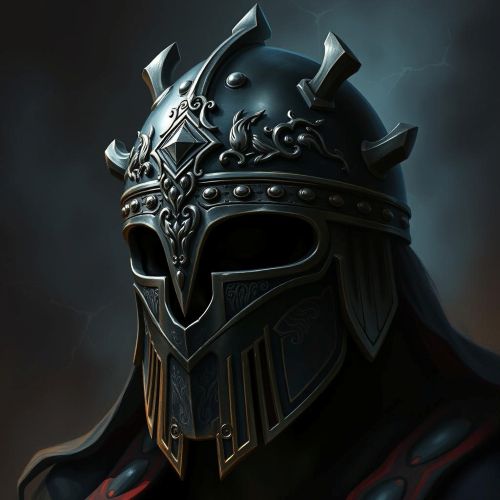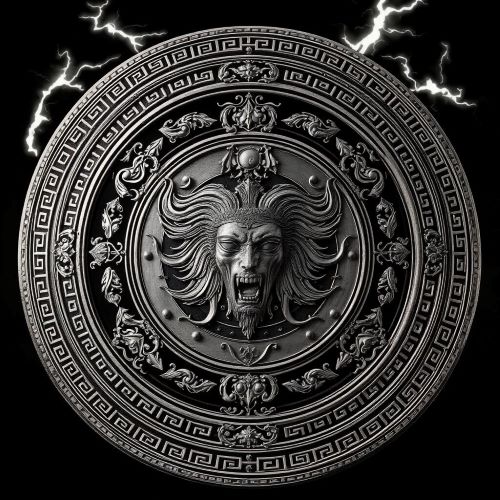
Helm of Darkness : Invincibility of Hades
Helm of Darkness
Introduction
In the vast and enigmatic realm of Greek mythology, few artifacts capture the imagination quite like the Helm of Darkness. Also known as the Cap of Invisibility or the Cap of Hades, this mystical item granted its wearer the power to vanish from sight—both physically and spiritually. Beyond its utility in warfare and divine missions, the helm has become a symbol of concealed power, fear, and the unknown. From gods to mortal heroes, many have worn it in pursuit of victory, vengeance, or survival. Let’s journey into the myth and might of this legendary helmet.
Origins
The origin of the Helm of Darkness can be traced back to the dawn of Olympian rule, during the epic struggle between the gods and the Titans known as the Titanomachy. When the Olympians freed the Cyclopes from imprisonment by the Titans, the grateful one-eyed giants rewarded their liberators with divine weapons forged in the fires of their unparalleled craftsmanship. To Zeus they gave the thunderbolt, to Poseidon the trident, and to Hades the Helm of Darkness.
This gift was particularly suited to Hades, who would come to rule over the Underworld—a realm both hidden from the living and shrouded in fear and mystery. Unlike his brothers, whose weapons were destructive and overt, Hades’ helm symbolized a more subtle power: the ability to remain unseen, to move unnoticed, and to exercise influence without spectacle. During the Titanomachy, Hades used the helm to devastating effect, sneaking past enemy lines and launching surprise attacks that turned the tide in favor of the Olympians.
Think you know your myths and legends? Dive into the world of ancient stories and test your knowledge with our engaging quizzes on Mythlok!
Powers
The defining power of the Helm of Darkness was its capacity to make its wearer completely invisible. This was not mere camouflage, but true concealment from all forms of detection—sight, magic, and even divine perception. Its enchantment cloaked the user in shadow, allowing them to pass undetected through any realm, mortal or divine.
The helm also carried an aura of fear and psychological disturbance. Ancient accounts describe how its presence, though unseen, could instill dread and unease in those nearby. It wasn’t simply a tool for hiding; it was a weapon of terror, unsettling those who sensed something they could not confront. Its power was not just in absence, but in the fear that absence provoked.
This unique nature of the helm reflected the essence of Hades himself—ruler of a world that is ever-present but hidden, a place of judgment and consequence that quietly governs the afterlife. The Helm of Darkness symbolized this unseen sovereignty, a manifestation of power that does not rely on presence to be felt.
Owners/Users
Though originally crafted for and bestowed upon Hades, the Helm of Darkness was not exclusive to him. In fact, throughout Greek mythology, it was loaned to other deities and mortals when the situation demanded stealth and discretion over might and force.
Hades, of course, was the primary wielder. His use of the helm was mostly tied to his duties as the god of the underworld, where discretion and the control of spirits required a quieter kind of command. He did not walk the Earth among mortals as his brothers did, but when he chose to, the helm allowed him to do so unseen.
Athena, goddess of wisdom and warfare, once used the helm during the Trojan War. In a tale that highlights both her strategic mind and martial prowess, she wore the helm to assist the warrior Diomedes in his battle against Ares, rendering herself invisible to the god of war and helping to turn the battle in Diomedes’ favor.
Hermes, the fleet-footed messenger of the gods, also donned the helm during a skirmish with the giants. His natural speed combined with the helm’s power made him an elusive and unstoppable force. In his role as a divine intermediary and trickster, the helm suited him well, enhancing his ability to move between realms unnoticed.
Perhaps the most famous mortal to use the Helm of Darkness was Perseus. In his quest to slay the monstrous Medusa, Perseus used the helm not in battle, but in escape. After decapitating Medusa, he used the helm to flee from her enraged sisters. As a demigod, his access to such a powerful artifact signified divine trust and necessity—he could not have survived without it.
Instances used
The Helm of Darkness appears at key moments throughout Greek mythology, its use often serving as a turning point in divine and heroic narratives.
During the Titanomachy, Hades utilized the helm to great effect. With it, he was able to move through enemy territory unseen, delivering surprise attacks that disoriented and weakened the Titans. This strategic advantage contributed significantly to the Olympians’ eventual victory and the establishment of their reign.
In the events of the Trojan War, Athena’s use of the helm to hide herself from Ares marked one of the few times divine interference was both literal and unseen. Her hidden guidance allowed Diomedes to wound Ares, a feat that would have been impossible under normal circumstances. The helm enabled an indirect intervention that changed the course of the battle without outright divine dominance.
Perseus’s tale showcases the helm in a different light—as a means of escape rather than assault. After slaying Medusa, who could turn any living thing to stone with her gaze, Perseus used the Helm of Darkness to evade her immortal sisters. This critical moment emphasized the helm’s importance as a tool of survival and strategy rather than pure aggression.
Hermes’s encounter with the giants further demonstrates how even gods relied on stealth in battles where brute strength alone could not guarantee success. With the helm, Hermes moved freely and undetected among his enemies, striking with impunity and ensuring victory for the Olympians.
Frequently Asked Questions
Lorem ipsum dolor sit amet, consectetur adipiscing?
Lorem ipsum dolor sit amet, consectetur adipiscing elit. Praesent convallis vestibulum justo, ac tincidunt nunc vehicula quis. Nullam id dolor quis orci malesuada feugiat. Curabitur aliquet libero at urna ullamcorper, ac ultricies nulla dapibus.
Lorem ipsum dolor sit amet, consectetur adipiscing?
Lorem ipsum dolor sit amet, consectetur adipiscing elit. Praesent convallis vestibulum justo, ac tincidunt nunc vehicula quis. Nullam id dolor quis orci malesuada feugiat. Curabitur aliquet libero at urna ullamcorper, ac ultricies nulla dapibus.
Lorem ipsum dolor sit amet, consectetur adipiscing?
Lorem ipsum dolor sit amet, consectetur adipiscing elit. Praesent convallis vestibulum justo, ac tincidunt nunc vehicula quis. Nullam id dolor quis orci malesuada feugiat. Curabitur aliquet libero at urna ullamcorper, ac ultricies nulla dapibus.
Lorem ipsum dolor sit amet, consectetur adipiscing?
Lorem ipsum dolor sit amet, consectetur adipiscing elit. Praesent convallis vestibulum justo, ac tincidunt nunc vehicula quis. Nullam id dolor quis orci malesuada feugiat. Curabitur aliquet libero at urna ullamcorper, ac ultricies nulla dapibus.
Lorem ipsum dolor sit amet, consectetur adipiscing?
Lorem ipsum dolor sit amet, consectetur adipiscing elit. Praesent convallis vestibulum justo, ac tincidunt nunc vehicula quis. Nullam id dolor quis orci malesuada feugiat. Curabitur aliquet libero at urna ullamcorper, ac ultricies nulla dapibus.
Watch
Source
“The Helm Of Darkness: Hades’ Mythical Weapon In Greek Mythology,” Sirioti, 2024-12-01. https://sirioti.com/blogs/greek-symbols-meaning/the-helm-of-darkness-hades-mythical-weapon-in-greek-mythology
“Helm of Darkness Facts for Kids,” Kids Kiddle. https://kids.kiddle.co/Helm_of_Darkness
“Helm of Darkness – Greek Mythology Wiki – Fandom.” https://greekmythology.fandom.com/wiki/Helm_of_Darkness
“Hades and the Helm of Darkness – Myth Crafts,” 2018-09-27. https://mythcrafts.com/2018/09/27/hades-and-the-helm-of-darkness/
“Cap of invisibility – Wikipedia.” https://en.wikipedia.org/wiki/Cap_of_invisibility
“The Helm of Darkness,” Greek Gods Heroes and Monsters Wiki. https://greek-gods-heroes-and-monsters.fandom.com/wiki/Helm_of_Darkness








